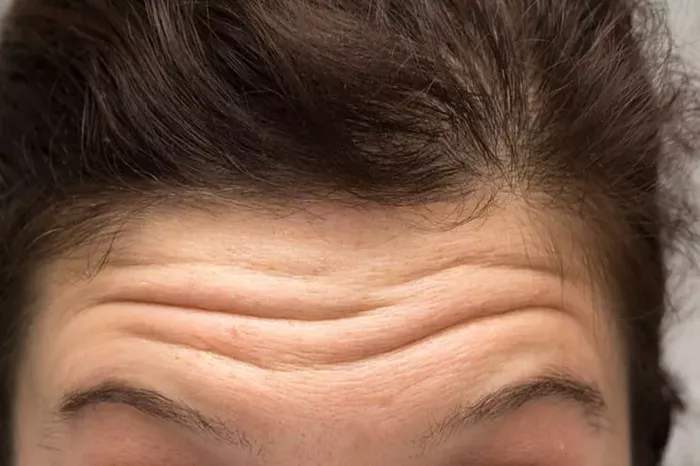Forehead wrinkles are a common concern for many individuals as they age, but they can also appear prematurely due to various factors. Understanding the reasons behind the development of forehead wrinkles can help in implementing preventive measures and choosing effective treatments. This article explores five primary reasons why forehead wrinkles occur, backed by scientific research and expert insights.
1. Aging and Decreased Skin Elasticity
One of the most significant contributors to forehead wrinkles is the natural aging process. As we grow older, our skin undergoes several changes that lead to the formation of wrinkles. The production of collagen and elastin, proteins crucial for maintaining skin elasticity and firmness, declines with age. This loss of elasticity makes the skin more susceptible to creasing and folding, particularly in areas like the forehead where facial expressions frequently cause repetitive motions.
Moreover, the skin’s ability to retain moisture decreases over time, further exacerbating the appearance of wrinkles. Environmental factors such as sun exposure also play a role in accelerating the aging process of the skin through photoaging, causing collagen breakdown and promoting the formation of wrinkles.
2. Facial Expressions and Muscle Movement
Dynamic wrinkles, including those on the forehead, are often linked to repetitive facial expressions and muscle movements. The forehead is particularly prone to wrinkles because it is involved in various expressions such as raising the eyebrows, frowning, and squinting. These movements contract the underlying muscles and, over time, lead to lines and creases on the surface of the skin.
Continuous muscle contractions, combined with reduced skin elasticity due to aging, create permanent lines known as expression lines or dynamic wrinkles. Habitual facial expressions, stress-induced facial tension, and even sleeping positions can contribute to the development of these wrinkles over the years.
3. Genetic Predisposition
Genetics play a crucial role in determining an individual’s predisposition to developing wrinkles, including those on the forehead. Some people inherit genes that affect their skin’s structure and how it ages. Factors such as skin thickness, oiliness, and susceptibility to sun damage can be influenced by genetic variations.
Studies have identified specific genetic markers associated with collagen degradation and skin aging. Understanding your genetic predisposition can provide insights into how proactive you need to be in adopting skincare routines and lifestyle habits to prevent or minimize forehead wrinkles.
See also: Best 5 Ways To Reduce Nasolabial Lines Naturally
4. Environmental Factors and Lifestyle Choices
Environmental factors and lifestyle choices significantly impact skin health and contribute to the formation of wrinkles. Chronic sun exposure is one of the most preventable causes of premature aging and wrinkles. Ultraviolet (UV) radiation from the sun penetrates the skin, causing oxidative stress, collagen damage, and elastin degradation, all of which accelerate the formation of wrinkles.
Other environmental factors such as pollution and exposure to harsh weather conditions can also contribute to skin aging and wrinkle formation. Lifestyle habits such as smoking, poor nutrition, inadequate hydration, and excessive alcohol consumption can further exacerbate skin damage and decrease skin elasticity, making the skin more prone to wrinkles.
5. Skincare Practices and Treatment Options
Effective skincare practices and treatment options can help prevent and reduce the appearance of forehead wrinkles. Establishing a daily skincare routine that includes gentle cleansing, moisturizing, and sun protection is essential for maintaining skin health and minimizing the effects of aging.
Topical treatments containing retinoids, antioxidants, and peptides can stimulate collagen production, improve skin texture, and reduce the visibility of wrinkles. Botulinum toxin injections (e.g., Botox) are commonly used to temporarily relax muscles responsible for dynamic wrinkles on the forehead, smoothing out existing lines and preventing new ones from forming.
For individuals seeking more intensive treatments, procedures such as chemical peels, microdermabrasion, laser resurfacing, and dermal fillers offer options to rejuvenate the skin and reduce the appearance of wrinkles. Consulting with a dermatologist or skincare specialist can help determine the most suitable treatment plan based on individual skin type, concerns, and desired outcomes.
Conclusion
Forehead wrinkles can develop due to a combination of factors, including aging, facial expressions, genetic predisposition, environmental influences, and lifestyle choices. While some factors such as genetics are beyond our control, adopting a proactive approach to skincare and lifestyle habits can significantly impact the prevention and treatment of wrinkles.
Understanding the underlying causes of forehead wrinkles empowers individuals to make informed decisions about their skincare routines and seek appropriate treatments when necessary. By addressing these factors early and implementing preventive measures, individuals can maintain healthier, more youthful-looking skin over time.
Related topics:
Top 5 Factors That Cause Wrinkles
How Long Does Frown Line Botox Last?

